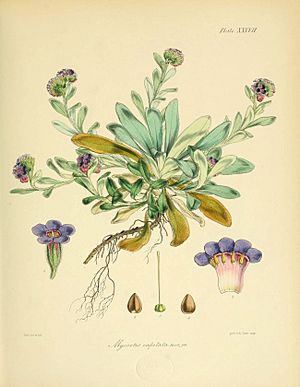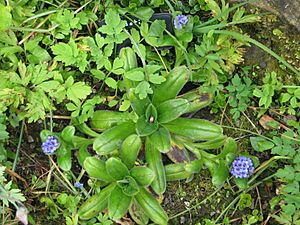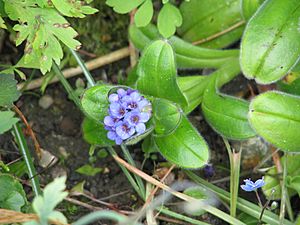Myosotis capitata facts for kids
Quick facts for kids Myosotis capitata |
|
|---|---|
 |
|
| Plate XXXVII of Hooker's Flora Antarctica | |
| Conservation status | |
|
Invalid status (NZ TCS)
|
|
| Scientific classification | |
| Genus: |
Myosotis
|
| Species: |
capitata
|
Myosotis capitata is a special kind of forget-me-not flower. It grows naturally only on the Campbell and Auckland Islands. These islands are located far south of New Zealand. A famous scientist named Joseph Dalton Hooker first wrote about this plant in the 1800s. He included it in his important book, Flora Antarctica.
What it Looks Like
Myosotis capitata grows in small, circular groups of leaves. These groups are called rosettes. Each leaf is quite long, about 3 to 12 centimeters (1 to 5 inches) in length. They are also wide, about 1 to 2.5 centimeters (0.4 to 1 inch) across. The ends of the leaves are usually rounded, but sometimes they have a sharp tip.
The top side of the leaves feels soft and silky. This is because it's covered in many long hairs. The bottom side of the leaves has fewer and shorter hairs.
The flowers of this plant grow in clusters. Each cluster usually has about eight flowers. These flowers sit on very short stems. The small green part that holds the flower (called the calyx) is about 3 to 5 millimeters long. The flower itself is a beautiful deep blue color. It has a tube shape at the bottom, and its petals are rounded and flat. After the flowers bloom, the plant produces tiny black seeds. These seeds are very small, only about 1 to 2.5 millimeters long.
This forget-me-not flowers from November to February. It then produces its seeds from December to February.
Where it Lives
You can find Myosotis capitata in many different places. It grows from sea level all the way up to 600 meters (about 2,000 feet) high. It likes to live on cliff faces and in areas with lots of rocks and boulders.
How it is Protected
This plant is considered "At Risk - Naturally Uncommon." This means it's not found in many places. It only grows on the Campbell and Auckland Islands. Because it has a very small natural home, it needs to be watched carefully. This status was given in 2018 under the New Zealand Threat Classification System. This system helps New Zealand keep track of its unique plants and animals.
Why it is Called capitata
The second part of the plant's name, capitata, comes from a Latin word. The Latin word is caput or capitis, which means "head." This name describes how the plant's flowers are arranged. They often grow in clusters that look a bit like a head. It can also refer to another part of the plant that has a head-like shape.
Gallery




